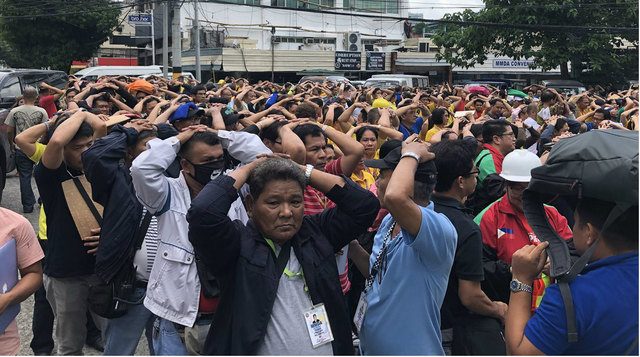SUMMARY
This is AI generated summarization, which may have errors. For context, always refer to the full article.

MANILA, Philippines – Even on its fourth annual run, the #MMShakeDrill is still “far from perfect,” Metro Manila Development Authority (MMDA) officials have said.
Testing Metro Manila with a drill that rocked the whole capital with a magnitude 7.2 earthquake simulation, the fourth #MMShakeDrill ended its overnight operations on Friday, July 20.(READ: MMDA’s #MMShakeDrill: How everything worked)
There were 3 main areas for improvement cited by the MMDA for the #MMShakeDrill: a premature short message service (SMS) announcement, the strategic location of command posts, and struggles with communication links.
According to MMDA Chief of Staff Michael Salalima, maintaining communication links between the different quadrants was “very challenging” as there were problems with the radios and satellite phones.
Announcements via SMS also showed problems in alerting the public, as not all users were able to receive a message.
The two-day operation
In a press conference conducted after the conclusion of the 2018 #MMShakeDrill on Friday, MMDA General Manager Jojo Garcia explained that this year’s operations lasted for two days to keep true to its protocol to earthquakes.
Due to the damage and casualties expected to result from the ‘Big One’, government agencies tasked for disaster response are expected to conduct overnight operations for damage assessment and monitoring.
“Dito po ang pinapraktis ng gobyerno, ng MMDA in particular, of course with the help of other government agencies, kung paano tayo makakatulong after the major earthquake,” explained Garcia.
(Here is where the government, MMDA in particular, of course with the help of other government agencies, can practice how we can help after the major earthquake.)
“That’s why we’re doing this kind of drill to minimize loss of life after the earthquake kasi dito natin makikita (because we can witness it here.),” added Garcia.
After the ceremonial pressing of the alarm, Garcia and MMDA Chairman Danilo Lim visited the four quadrants that sectioned Metro Manila and select Local Government Units. This protocol was set in place for the situational assessment of damage done across the different quadrants.
Garcia said, however, that the #MMShakeDrill highlighted one problem spot in pushing through with an earthquake drill: heavy traffic coupled with drivers’ noncooperation slowed them down.
“Ang services ng gobyerno mas mapapabilis ‘to kung ang motorista mismo mag cooperate at mag participate,” suggested Garcia.
(Government services would be faster if motorists themselves would cooperate and participate.)
He explained the usage of a helicopter for this protocol would be advised due to time constraints.
“[To be] as realistic as possible, the element of time was very important,” said MMDA Chief of Staff Michael Salalima.
Based from the reports garnered after the earthquake scenarios conducted across the different quadrants, the total number of casualties amounted to 14,480 people dead.
Rating the exercise
Even with this number, Garcia gave this year’s #MMShakeDrill an 85/100 – 10 points higher than last year – due to the participation of all government offices and a number of private institutions, businesses, and schools.
He also commended the readiness of the different quadrants and local government units to respond to disasters. However, he estimated the overall participation in the #MMShakeDrill to be less than 50%. (LOOK: IN PHOTOS: Metro Manila prepares for the ‘Big One’)
Command centers across the various quadrants built for the #MMShakeDrill will remain in their designated spots for quick disaster response.
“After the drill, nandiyan lang yan para kung anong mangyari na sakuna, hindi na kailangan magdala ng tao natin ng gamit,” said Garcia.
(After the drill, they will stay there so people won’t have to bring equipment to deal with disasters.)
Premature alerts
This year, Metro Manila Development Authority (MMDA) upped its simulation by keeping the exact date of the #MMShakeDrill as a surprise. However, on July 19, a premature text blast alerted the public of the 1 pm #MMShakeDrill to occur that day. (READ: Jolted netizens liken #MMShakeDrill phone alarm to ‘The Purge’ siren)
Despite the two-hour advanced notice to the public, the #MMShakeDrill was an effort to assess Metro Manila’s response to a magnitude 7.2 earthquake.
Various studies have shown that an earthquake of that magnitude would become the worst case scenario of the expected movement of the West Valley Fault set to occur within our lifetime. (READ: What dangers await when the West Valley Fault moves?)
This is the fourth consecutive year that MMDA has staged the Metro Manila-wide earthquake drill.– Rappler.com
Add a comment
How does this make you feel?
There are no comments yet. Add your comment to start the conversation.